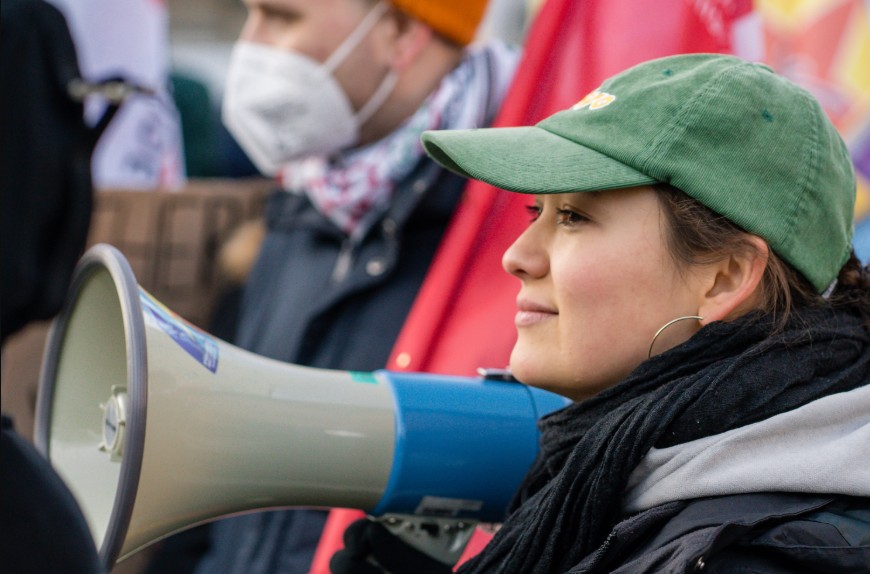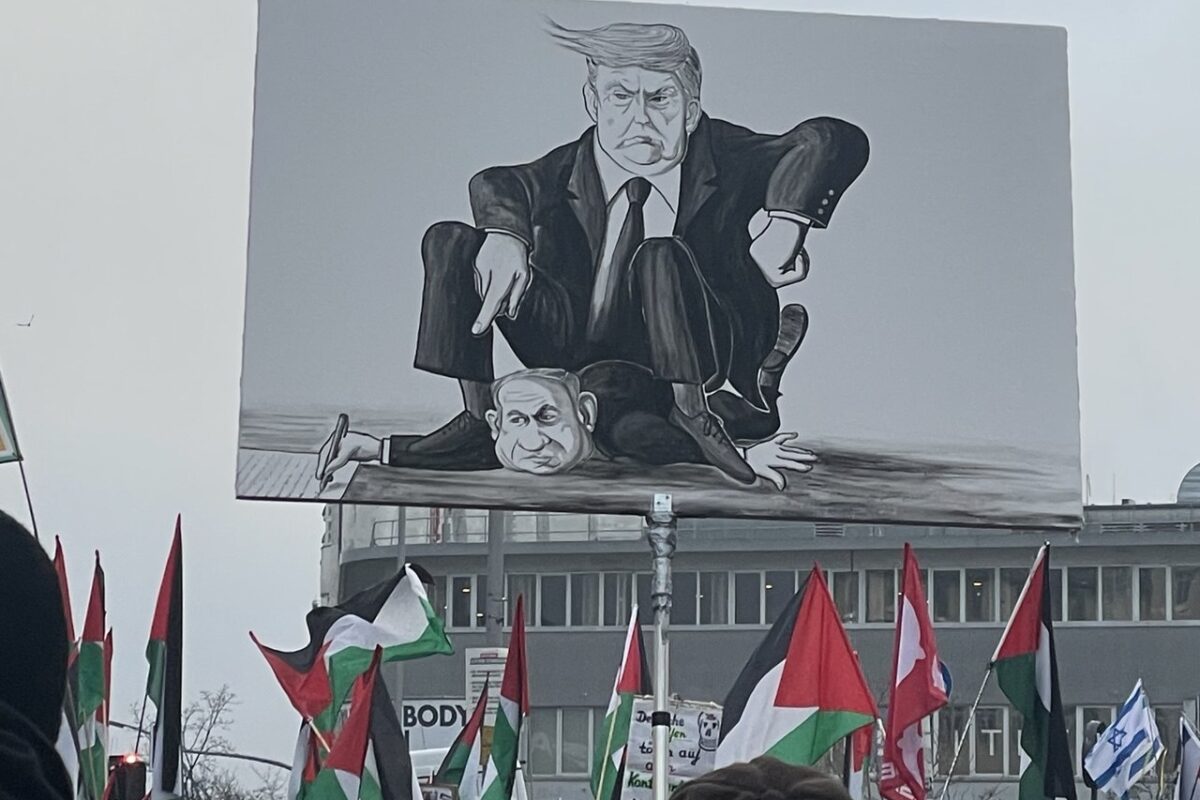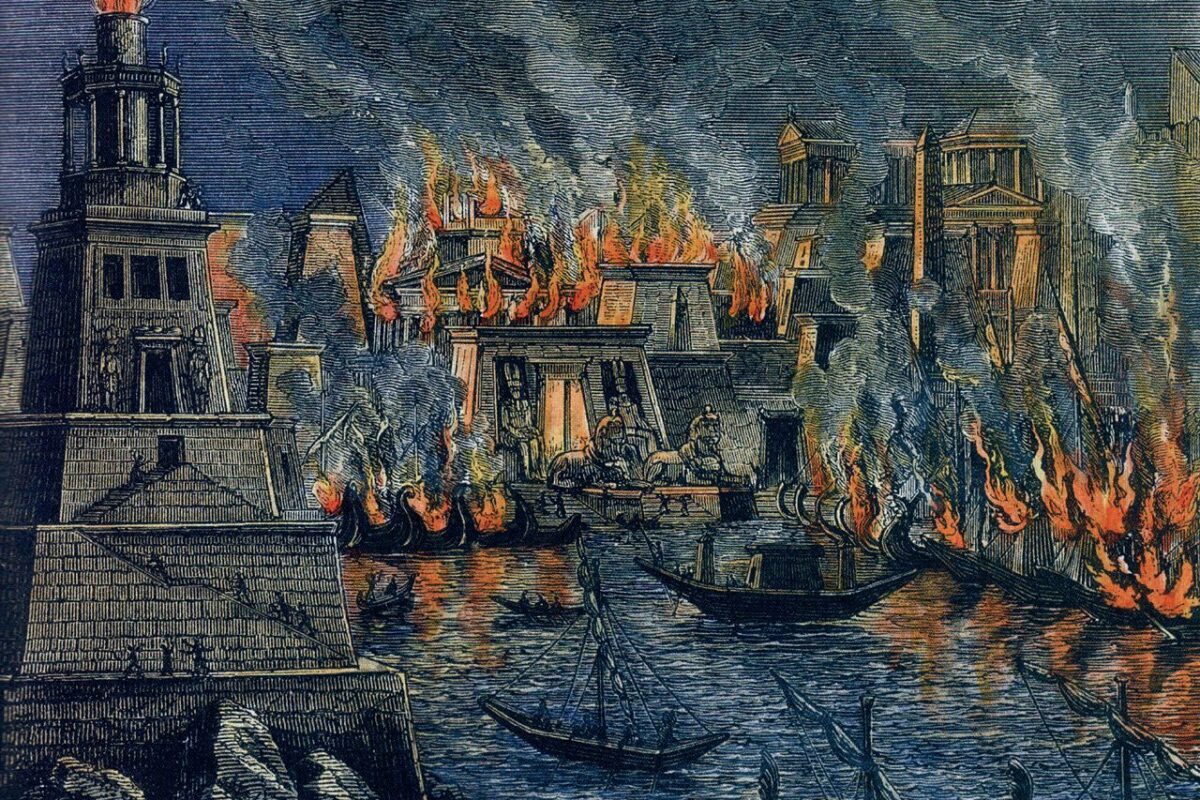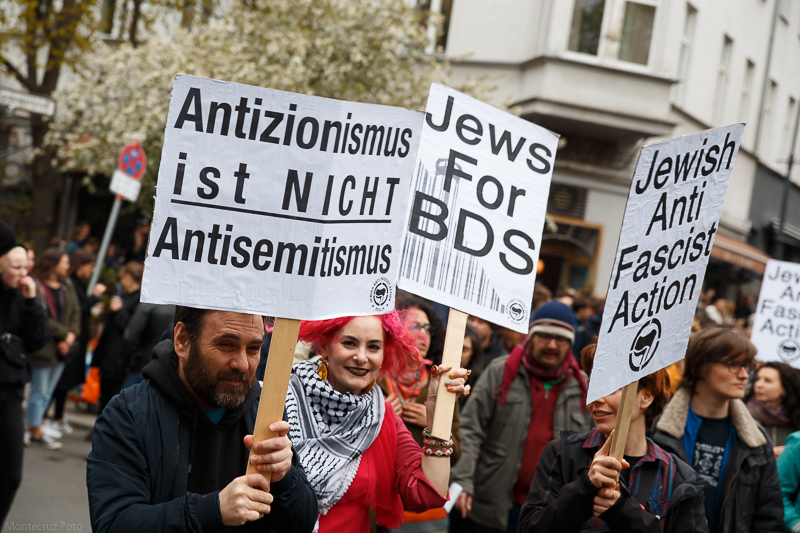This is the German version of an Open Letter which you can read here.
Wir, Studierende, Lehrende und Mitarbeitende an deutschen Hochschulen, sind alarmiert über die Resolution „Antisemitismus und Israelfeindlichkeit an Schulen und Hochschulen entschlossen entgegentreten sowie den freien Diskursraum sichern“. Vorgeblich der Antisemitismusbekämpfung gewidmet, stellt diese vielmehr eine Bedrohung für die Sicherheit von Schüler:innen und Student:innen dar und ruft zur Untergrabung der Wissenschaftsfreiheit und Hochschulautonomie auf. Wir schließen uns der Kritik von Wissenschaftler:innen, Antisemitismusforscher:innen aus Deutschland und internationaler Fachgesellschaften an und treten der Resolution mit ihren absehbaren und gravierenden Folgen für Wissenschaftsfreiheit und Perspektivenvielfalt entschieden entgegen. Auch mehreren Jurist:innen zufolge wirft die Resolution zahlreiche schwerwiegende verfassungsrechtliche Bedenken auf.
Am 7. November 2024 hat der Deutsche Bundestag eine erste Resolution unter dem Titel „Nie wieder ist jetzt: Jüdisches Leben in Deutschland schützen, bewahren und stärken“ trotz heftiger Kritik, mit mehrheitlicher Zustimmung aus nahezu allen Parteien, inklusive der AfD, verabschiedet. Nun wurde eine weitere Resolution vorgelegt, die sich gegen Antisemitismus richtet – an Schulen und Hochschulen in Deutschland. Sie wird voraussichtlich Anfang Dezember zur Abstimmung eingereicht.
Die Resolution nährt eine verzerrte Darstellung, die palästinasolidarischen Aktivismus verunglimpft, und untergräbt die Rolle der Universität als Ort des offenen Austauschs und der politischen Debatte1. Sie fordert den „Austausch zwischen Hochschulen und Sicherheitsbehörden […] in Intensität und Regelmäßigkeit“ (III.2), die Ausweitung rechtlicher Maßnahmen und repressiver Instrumente, die Verstärkung von Sicherheitsmaßnahmen und den Ausschluss von Studierenden, die unerwünschte Ansichten äußern. Laut der Resolution dürfen Unterstützer:innen “der ‘Boycott, Divestment and Sanctions’-Bewegung (abgekürzt BDS) sowie ähnlich gesinnte Bewegungen […] in deutschen Bildungs- und Wissenschaftseinrichtungen keinen Platz haben“ (III.10). Die Verwendung einer so unpräzisen Sprache, um festzulegen, wer von deutschen Universitäten ausgeschlossen werden soll, ist alarmierend und erweitert das Ausmaß staatlicher Repression weit über die pro-palästinensische Studierendenbewegung hinaus. Zudem isoliert die Resolution deutsche Universitäten von internationalen Partnerinstitutionen, setzt sie in Widerspruch zum internationalen Völkerrecht, untergräbt ihre Glaubwürdigkeit und riskiert weltweite Gegenreaktionen.
In Gaza wurden alle Schulen und Universitäten seit Oktober 2023 durch Israel bombardiert und buchstäblich zerstört. Israel ist für die Tötung unzähliger Studierender, Forschender, Künstler:innen, Ärzt:innen und Journalist:innen im Gazastreifen verantwortlich, was einem Scholastizid des palästinensischen Bildungswesens gleichkommt. Einem Sonderausschuss der Vereinten Nationen nach, entspricht das Vorgehen Israels in Gaza einem Völkermord, an dem sich Deutschland unter anderem mit Waffenlieferungen beteiligt. Auf internationaler Ebene wurde Deutschland deshalb bereits Mitschuld am Völkermord vorgeworfen und verteidigt Israel dennoch weiterhin gegen entsprechende Klagen vor dem Internationalen Gerichtshof.
Auf nationaler Ebene setzen der Staat und Institutionen, im Namen eines vermeintlichen Schutzes jüdischen Lebens in Deutschland, immer mehr repressive Maßnahmen und Abschreckungstaktiken gegen palästinasolidarische Personen ein, zu denen auch viele jüdische Personen zählen, und untergraben so ihre Meinungsfreiheit und ihr Recht auf politische Meinungsäußerung. Die vorgelegte Resolution stärkt genau diese Instrumente, die zur Rechtfertigung polizeilicher Gewalt gegen Student:innen sowie Kündigungen von Künstler:innen, Dozent:innen, Redner:innen, Forschenden und anderen aufgrund ihrer politischen Ansichten benutzt wurden und werden2.
Die Resolution untergräbt die wissenschaftsimmanenten meritokratischen Prozesse der Fördermittelvergabe, indem sie betont, dass „Fördermittel des Bundes ausschließlich nach dem Maßstab der wissenschaftlichen Exzellenz vergeben werden“ und „wissenschaftliche Exzellenz und Antisemitismus einander ausschließen“ (III.9). Sie beruft sich dabei allein auf die umstrittene Antisemitismusdefinition der International Holocaust Remembrance Alliance (IHRA), die Kritik an Israel mit Antisemitismus gleichsetzt. Substanzielle Kritik an der Ungenauigkeit und dem dokumentierten Missbrauch dieser Definition zur Diskriminierung von Personen aufgrund ihrer politischen Meinung wird ignoriert. Folglich wird die Freigabe von Bundesmitteln von den politischen Ansichten der Wissenschaftler:innen abhängig gemacht, was legitime Kritik an der israelischen Politik zum Schweigen bringen soll. Die Freiheit der Forschung ist unvereinbar mit der staatlichen Kontrolle von Forschungsmittelvergaben und der Überwachung privater und politischer Äußerungen und Betätigungen3.
Die Resolution weitet die einseitige Lehre über Antisemitismus und den Staat Israel im Rahmen der Bildung über den Nahen Osten aus, während sie Palästina und Palästinenser:innen, die nur im Rahmen der Hamas erwähnt werden, als legitime Themen der Lehre und Forschung ausklammert. Der Beutelsbacher Konsens, der gegen die Indoktrination aus dem Dritten Reich entwickelt wurde, sieht vor, dass Lernende Zugang zu verschiedenen Perspektiven auf gesellschaftliche und politische Fragen bekommen und somit in die Lage versetzt werden, kritisch zu denken und sich eine eigene Meinung zu bilden. Die in der Resolution propagierte Einseitigkeit in Forschung und Lehre widerspricht der unabhängigen, kritischen und von politischer Indoktrination freien Bildung.
Wir lehnen die Resolution aus diesen Gründen ab und fordern einen Ansatz, der unterschiedliche Perspektiven respektiert und die Wissenschaftsfreiheit wahrt.
FORDERUNGEN
Wir, die Unterzeichnenden, fordern Universitätsverwaltungen, Fakultätsleitungen, Studierendenvertreter:innen, Studierendeninitiativen und Universitätsmitarbeitende auf, eine prinzipientreue Haltung gegen die autoritäre Bedrohung durch die vorgeschlagene Resolution einzunehmen.
Wir fordern, dass die oben genannten Parteien
- eine klare öffentliche Haltung gegen die Untergrabung der Wissenschaftsfreiheit, der Meinungsfreiheit und die Verletzung der Hochschulautonomie durch die Resolution einnehmen.
- die Verwendung der IHRA-Definition als alleinige, offizielle und rechtliche Definition von Antisemitismus an Forschungs- und Bildungseinrichtungen ablehnen.
- die Forderung nach verstärkter Versicherheitlichung an Hochschulen durch „engen Austausch mit den Sicherheitsbehörden“ (III.12.e) und karzerale Logiken ablehnen, in dem sie u.a. eine Antirassismus- und Antidiskriminierungsstelle einrichten und unabhängige Protokolle für die Deeskalation von Konflikten ohne Polizeipräsenz etablieren.
- der antipalästinensischen Voreingenommenheit mit ausgewogenen Lehrplänen begegnen, die palästinensische Geschichte auf allen Ebenen der Bildung, palästinensische Wissensproduktion und Lehre über Palästinenser:innen, die über ihre Rolle als besetztes Volk hinausgeht, einbeziehen.
- „eintreten für Forschung und Lehre im Einklang mit dem Völkerrecht und für konsequentes Handeln bei Nichteinhaltung durch Universitäten, Forschungsinstitute und andere akademische Einrichtungen“ (Zitat aus den Arbeitsprinzipien der Allianz Kritische und Solidarische Wissenschaft).
Endnoten
1 In der Resolution werden selektiv Studien der Universität Konstanz zitiert, wobei wichtige Ergebnisse ausgelassen werden, die zeigen, dass der Antisemitismus unter Studierenden geringer ist als in der Allgemeinbevölkerung (Quelle).
2 Das Projekt “Archive of Silence” dokumentiert Fälle von Kündigungen, Entladungen, und anderen Formen der Unterdrückung pro-palästinensischer – unter anderem jüdischer – Stimmen (Quelle) .
3 Im Frühjahr 2024 wurde beispielsweise ein Mädchentreff in Berlin aufgrund der politischen Einstellungen der Mitarbeitenden fristlos gekündigt (Quelle), gleichzeitig ließ das BMBF prüfen ob man Forscher:innen, die sich gegen die Kriminalisierung von propalästinensischen Studierenden geäußert hatten, die Fördermittel streichen könnte (Quelle). Das Vorgehen der zum Zeitpunkt des BMBF Skandals “Fördergate” amtierenden Ministerin wird im Resolutionsentwurf explizit begrüßt (I.), was alarmierend ist.
___________________________________________________________________________________
Erstunterzeichner:innen
Gruppen
Not In Our Name TU Berlin
Not In Our Name ASH Berlin
Not In Our Name UdK Berlin
Linksjugend [‘solid] Hessen
Linksjugend [‘solid] Fulda
DieLinke.SDS Fulda
DieLinke.SDS Marburg
Students for Palestine FU Berlin
Students for Palestine Hannover
Students for Palestine Würzburg
Students for Palestine Bonn
Students for Palestine Freiburg
Students for Palestine Halle
Students for Palestine Hamburg
Students for Palestine Münster
Students for Palestine Fulda
Students for Palestine Leipzig
Students for Palestine Darmstadt
Bündnis Palästinasolidarität Marburg
BAK Klassenkampf in der Linksjugend [‘solid]
Uni(te) for Pali, Bremen
Queer Liberational Action
Decolonize Charité Berlin
Decolonize HU
Ingolstadt Eichstätt for Palestine
Stand UP for Palestine
Kritische SKA, Leipzig
KIARA (Kritische Islamwissenschaftler*innen und Arabist*innen), Leipzig
Einzelpersonen (alphabetisch)
Enrica Audano, Universität Leipzig
Prof. Michael Barenboim, Barenboim-Said Akademie
Niklas Barth, Linke Frankfurt am Main
Prof. Dr. Christine Binzel, FAU Erlangen-Nürnberg
Adam Broomberg, Künstler
Dr. Irene Brunotti, Universität Leipzig
Prof. Celine Condorelli
Dr. Mark Curran
Jasmin Daka
Prof. Dr. Dr. Donatella Della Porta, Scuola Normale Superiore
Anna Ehrenstein
Dr. Jannis Julien Grimm, Freie Universität Berlin
Hanna Hertel, Studentin, Mitglied GEW Berlin
Dr. Thomas Herzmark, Universität Göttingen
Dr. Angela Last
Lucilla Lepratti, Universität Leipzig
Dr. Lara Krause-Alzaidi, Universität Leipzig
Urs Kollhöfer, Mitglied im Landesvorstand der Linken Hessen
Urs Kroll, Student, Mitglied GEW Berlin
Dr. Nils Riecken, Ruhr-Universität Bochum
Matthias Riedl, Mitglied im Landesvorstand der Linken Hessen
Prof. Dr. Marc Siegel, Johannes Gutenberg-Universität Mainz
Maxi Schulz, Student*in, Mitglied GEW Berlin
Prof. Dr. Hendrik Süß, Friedrich-Schiller-Universität Jena
Margarita Tsomou, Kuratorin
Laura Oettel, Studentin, Mitglied GEW Berlin
Antonia Marquardt, Jugendpolitische Sprecherin der Linken Hessen
Prof. Dr. Agata Lisiak, Bard College Berlin
Prof. Dr. Olaf Zenker, Martin-Luther-Universität Halle-Wittenberg
Weitere Unterstützer:innen
- Prof. Dr. Schirin Amir-Moazami
- Elakoum Mounib
- Prof. Dr. Michael Zander, Hochschule Magdeburg-Stendal
- Nasrin Karimi Rechtsanwältin
- Amanda Pope
- Norbert Lang, Journalist
- John Lütten, Universität Hamburg
- Prof. Dr. Robin Celikates, Freie Universität Berlin
- Julia Vogel
- Prof. Dr. Susanne Leeb, Kunsthistorikerin, Berlin/Lüneburg
- Aino Korvensyrjä, Freie Universität Berlin
- Dr. Carmen Becker
- Prof.Dr. Sabine Broeck, Universität Bremen
- Maher Ben Abdessalem
- PD Dr. Julia Vorhölter, Max Planck Institut für ethnologische Forschung
- Phillipp Slanina, Student
- Dr. Roy Karadag, Universität Bremen
- Prof. Dr. Manfred Liebel, Berlin/Potsdam
- Carla Schumann, Studentin, Martin-Luther-Universität Halle-Wittenberg
- Annefei Borgs-Uhlendorf
- Prof. Dr. Uli Beisel, Freie Universität Berlin
- Carolin Loysa, Freie Universität Berlin
- Jamal Sreiss
- Dr. Jeanne Féaux de la Croix
- Prof. Dr. Angela Harutyunyan, UdK Berlin
- Dr. Hanna Nieber, Max-Planck-Institut für ethnologische Forschung
- Kawthar El-Qasem, Düsseldorf
- Dr. Anne Menzel, Institut für Friedensforschung und Sicherheitspolitik an der Universität Hamburg
- Yuri Kwon
- Dr. Jannik Schritt, Universität Göttingen
- Prof. Dr. Anika König, Freie Universität Berlin
- Linda Beck, Universität Göttingen
- Wolfgang Lörcher, DIE LINKE Fulda
- Leonie Benker, Freie Universität Berlin
- Dr. Mathias Delori, CNRS-Forscher, Centre Marc Bloch
- Prof. Dr. Alice von Bieberstein, Humboldt Universität zu Berlin
- Nick Bley, Senator Universität Kassel
- Thomas Götzelmann, Martin-Luther-Universität Halle-Wittenberg
- Aaron Miller, Universität Leipzig, Max Planck Institute for Human Cognitive and Brain Sciences
- Raphaël Grisey, Filmmacher
- Marina Luna, Free University Berlin
- Christin Sander, FU Berlin
- Dr. Philipp Zehmisch, Universität Heidelberg
- Dr. Nicole Wolf, Universität London und freiberufliche Dozentin Berlin
- Dr. Benjamin Schütze, Arnold Bergstraesser Institut (ABI) Freiburg
- Prof. Dr. Martin Sökefeld, LMU Müchen
- Pia Berghoff, Freie Universität Berlin
- Daniel Shuminov, Goethe Universität
- Dr. Bettina Gräf, LMU München
- Prof. Dr. Wolfgang M. Schröder, Universität Würzburg
- Mithu Sanyal, Schriftstellerin und Kulturwissenschaftlerin
- Prof.Dr. Rupa Viswanath, Universität Göttingen
- Alma Kulha
- Aseela Haque, Freie Universität Berlin
- Susanne Schultz, Goethe-Universität Frankfurt/Main
- Anil Shah, Universität Kassel
- Dr. Ximena Alba
- Marius Bickhardt (Centre Marc Bloch/Sciences Po Paris)
- Huan Chen, Universität Münster
- Prof. Dr. Dominik Mattes, Freie Universität Berlin
- Christian Strippel, Weizenbaum-Institut
- Anna Hofmann Fraktionsvorsitzende der Linken im Landkreis Marburg-Biedenkopf
- Laure Piguet, Centre Marc Bloch/Université de Fribourg
- Noémie Regnaut, Université Paris-Sorbonne Nouvelle – Centre Marc Bloch Berlin
- Anonym, Centre Marc Bloch/EHESS
- Dr. Déborah Brosteaux, Marc Bloch Zentrum (Berlin)
- Marianne Adam (Centre Marc Bloch/Université de Tours)
- Florian Muhl, Universität Hamburg
- Mareike Biesel, Universität Göttingen
- Karlotta Bahnsen, Freie Universität Berlin
- Layla Kiefel (Universität Konstanz, Centre Marc Bloch)
- Elfi Padovan Münchner Friedensbündnis
- Dr. Dörthe Engelcke, Max Planck Institute for Comparative and International Private Law
- Philipp Rauch, Student TU Darmstadt
- Rebeka Nasir, Studentin, Technische Universität Darmstadt
- Kaoutar H., Goethe Universität Frankfurt
- Leon Kianzad, Goethe-Universität Frankfurt/Main
- Christos Kourris, TU Dresden
- Claire van Loon, Studentin
- Anna Müller
- Miriam Bartelmann, Arnold-Bergstraesser-Institut (ABI) Freiburg
- Luis Kliche Navas, Freie Universität Berlin
- Dr. Barbara Orth, IRS
- Dr. Tobias Schmitt, Universität Hamburg
- Ariane Alba Marquez, Bundesvorstand DieLinke.SDS, Goethe-Universität Frankfurt/Main
- Prod. Dr. Aram Ziai, Universität Kassel
- Nicholas Sagberger – Uni Regensburg
- Dr. Alix Winter, Centre Marc Bloch
- Willi Hertelt, Kurt-Tucholsky-Oberschule Berlin
- Layla Kiefel (Universität Konstanz, Centre Marc Bloch)
- Qusay, TU Darmstadt
- Christoph Maier, Uni Leipzig
- Mira Schmitz, MLU Halle-Wittenberg
- Prof. Dr. Wolfgang Gabbert, Leibniz Universität Hannover
- Kim Lucht, FSU Jena
- Lea Berger
- Barbara Gamper, Künstlerin und Pädagogin
- Taosif Talukder, TU Darmstadt
- Dr. Christian Ambrosius, Freie Universität Berlin
- Jorinde Becker, Hochschule für Grafik und Buchkunst Leipzig
- Jared Cobain HGB Leipzig
- Anna Orinsky, European University Institute
- Prof. Dr. Johanna Schaffer, Kunsthochschule Kassel
- Andreas Weiß, Köln
- Eliane Diur, Hochschule für Grafik und Buchkunst Leipzig
- Madlen Ernst, MERA25 Berlin
- Abdullah Rahhal – Die Linke Freiburg und Masterstudent Uni Freiburg
- Rana Brentjes
- Sonja Brentjes, Bergische Universität Wuppertall
- Mareike Biesel, Universität Göttingen
- Thomas Ruffmann, Kleve, Musiker, politischer Erwachsenenbildner
- Dr. Raquel Rojas, Freie Universität Berlin
- Tabea Knerner, Albert-Ludwigs-Universität Freiburg
- Sara Türen
- Frank Madsen Journalist
- Prof Ramis Örlü, Royal Institute of Technology, Stockholm, Schweden
- Prof. Dr. Christin Bernhold, Universität Hamburg
- Jasmin Sarah Hahn, Freie Universität Berlin
- Anna-Lena Kutzki, HAW Hamburg
- Sonja Rohan, Freie Universität Berlin
- Janine Schneider
- Luise Dechow, Universität Hamburg
- Leyla Tewes
- Clemens Grünberger
- Samah Schmitt-Razzougui
- Verena Müllner
- Selim Heers, Universität Leipzig
- Hava Aras
- Ahmed Tarek Alahwal, Universität Freiburg
- Raina Ivanova
- Hiba Banat, Studentin
- Graciela Bach
- Candice Breitz
- Dagmar Kohlmeier, Masterstudentin, Universität Freiburg
- Felicia Schmidt, Berlin
- Bircan Sönmez, Mera25 NRW, Düsseldorf
- Guillaume Carpentier, Mera25
- Christian Suhr – About People Film Produktion
- Deniz Khalifé
- Adrian Khalifé
- Louay Khalifé
- Ilay Khalifé
- Isa Khalifé
- Ayesha Siddiqi-Sikora
- Nadia El-Ali, Freie Universität Berlin
- Peter Förster, AK Zivilklausel der Uni Köln, Student
- Luca Groß, SDS Frankfurt
- Franziska Hildebrandt, SDS Uni Hamburg
- Marlies Wehner, M.A., Fachstelle für interkulturelle Bildung und Beratung-FiBB e.V.
- Jasper Wittenburg
- J. Kamo Anselm, UHH
- Emily Allegra Dreyfus, Filmuniversität Babelsberg
- Dr. David Jordan, Ruhr-Universität Bochum
- Prof. Dr. Claudius Zibrowius, Ruhr-Universität Bochum
- Artur Brückmann, Universität Hamburg
- Therese Friedemann
- Alp Kayserilioğlu, Universität Tübingen
- Peter Förster, AK Zivilklausel Uni Köln
- Eliaz Zeilmeir, Goethe Universität Frankfurt
- Rand Ashqar, Freiburg Universität
- Jean-Marie Yazbeck, Master Student University of Freiburg
- Anonym, Universität Freiburg
- Selma Härnqvist
- Muayad Chalabi, Technische Universität München
- Andrea Sittoni, LMU München
- Francisco Torres, Fraunhofer ISE
- Richard Lenerz, Universität Trier
- Lenna Fischer – Uni Hannover
- Jana Müller, Studentin
- Johannes Heißler, LMU München
- Lale Khoshnoud, Hochschule Hannover
- Eudy Mahlies, Universität Leipzig, Leibniz Institute for Tropospheric Research (TROPOS)
- Ingo Jäger, Bezirksratsherr Hannover Vahrenwald-List
- Marwan Abdelaal, Technische Universität München
- Michael Kreich
- Michelle Schinkel, Universität Konstanz
- Hanna Neghabian, SfP
- Gianluca Pagliaro, Max Planck Institute for Gravitational Physics
- Miriam Bartelmann, Arnold-Bergstraesser-Institut (ABI), Freiburg
- Björn Pohl
- Leonie Hiller
- Jasper Martins, Leibniz Universität Hannover
- Amir Raza (Albert Einstein Institute Hannover)
- Franziska Bax, Rachel Carson Center LMU München
- Mariel Bernnat, Universität Freiburg
- Lucia Grimm (Albert Ludwigs Universität Freiburg)
- Prof. Dr. Tahani Nadim
- Cora Orlando, Albert-Ludwigs-Universität Freiburg
- Prof. Dr. Encarnacion Gutierrez Rodriguez, Goethe-Universität Frankfurt
- Sören Horn, Kritische-Min-Studierende (Uni Hamburg)
Weitere unterstützende Gruppen
Bündnis Yousef Shaban
Estudantes por Justiça na Palestina (FCSH Nova, Portugal)
Students for Palestine Mainz
Sozialistisch-Demokratischer Studierendenverband (DieLinke.SDS)
Students for Palestine Frankfurt
Die Linke Hessen
Hochschule for Palestine Darmstadt
Studis gegen Rechts Leipzig
Fachschaftsrat Politikwissenschaft (Universität Leipzig)
Uni for Palestine Munich
Linksjugend [‘solid] Leverkusen
Decolonise HU, Berlin





